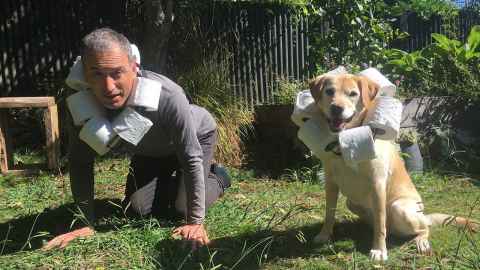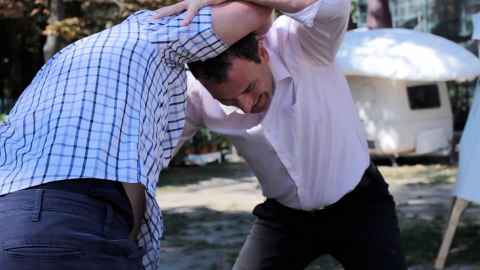The art goes on, with loo rolls
23 April 2020
These are hard-to-describe times, but Dr Mark Harvey of Dance Studies has explored them from the perspective of his Labrador, Lara, in a video called “Let’s Share the Ground Together”.

Dr Harvey is a senior lecturer in Dance Studies at the University, and an artist whose works explore and consider big world issues, often through idiocy, humour and a touch of the absurd.
“Let’s Share the Ground Together”, in which “the idiot guy goes crazy in backyard”, features Dr Harvey and his dog wearing ‘Elizabethan’ ruffs fashioned out of rolls of toilet paper, a riff on the grocery item that flew off the shelves in the early days of the pandemic.
“We appear to have spread this virus from the animal kingdom, so I wanted to explore the lives of animals around us, in this case, the life of my dog - to follow my dog, to see things from her perspective.”
Life as a dog isn’t easy, he discovered. “Dogs are very nimble, so it’s difficult to emulate the way they move. Keeping your nose to the ground, and being on the alert all the time, is really hard work!”
Capturing his life from the point of view of Lara was a family affair. “They say never involve kids or animals in making art, and I did both and it was great fun for us all, and very informative.” His daughter Tui filmed, and his other daughter, Sanne, kept things (and Lara) moving by waving around a dog treat off-camera. “Lara is a Labrador, so it’s all about the food.”
“This is a serious issue!” he adds.
Dogs are very nimble, so it’s difficult to emulate the way they move. Keeping your nose to the ground, and being on the alert all the time, is really hard work!”
“Lets Share the Ground Together” builds on Dr Harvey’s previous works. In 2017, in a performance called “Guilty Patch” (performed at Carriageworks in Sydney and CoCA in Christchurch) he invited people to lie down on a round carpet, and exchange guilt stories in confidence. “It’s amazing what people told me. But I can’t tell you what they told me.”
In “Political Climate Wrestle”, which he performed at the Venice Biennale in 2013 and in ten other countries around the world, he dressed up as a businessman and approached strangers in the street to “argue with them about climate change and politics and to wrestle” with them (in accordance with OSH guidelines).
In February this year he performed his work “We Can Shift the World Together” on the Wellington waterfront in the Performance Arcade, in which he invited thousands of people to help him shift a shipping container, manually. It was a way to explore what motivates people to do the things they do, or don’t, in the world around us.
“Of course I’m interested in the big questions, on how to make the world a better place – but also how we can we connect people around these big issues, to explore what motivates people to consider and act on issues such as climate change, colonisation and inequality, but by taking a sideways rather than didactic approach.”
A sense of humour is essential. “Humour is a useful way to get people thinking about those big world topics, and to engage with members of the public, not just art audiences.” When people can relate through humour they can allow themselves to be open to connecting deeply to issues.
“It’s really important to me that public performance is a learning experience, something that we can grow and learn from, from a position where we each feel valued. That might sound a bit ‘feel-good’, but it’s about encouraging people to think about what we can do without isolating them or simply telling them they have done something bad. Art has an extremely important role in our society in this way, which is usually ignored and undervalued.”
Isolation and lockdown has also been a learning experience, for both teachers and students. “Teaching online definitely has its challenges, and a big concern is that not all students have same online access, which is something we’re working on.”
“But our students are coming up with all sorts of work that responds to their current environment, using PPE, for instance, or playing on living in their own personal bubble.”
As has occurred throughout history our environment affects the art we make and the art we need, and isolation has sparked some creative responses from within his own bubble and from his students’ bubbles.
“I’m not saying artists should suffer, because I don’t think they should at all, and the wider literature suggests they do their worst when they suffer. But the challenges our students are currently facing is also producing some really exciting and interesting performance art and choreography right now.”

Media contact
Margo White | Media Adviser
Communications Office
Tel 09 923 5504
Mob 021 926 408
Email margo.white@auckland.ac.nz